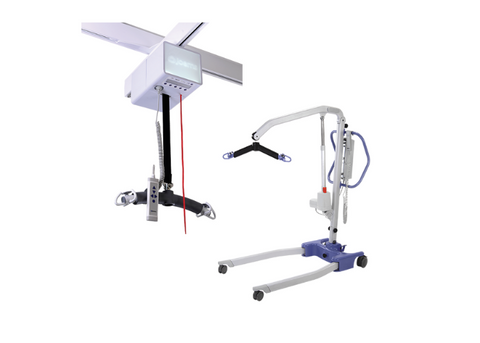Patient lifters are specialised devices used in healthcare settings to safely and efficiently transfer patients with limited mobility. Lifters offer numerous benefits, including reducing the risk of injury to patients and caregivers, increasing patient comfort and dignity, and improving efficiency and workflow in healthcare facilities. By providing a safe and effective means of transferring patients, lifters enable caregivers to provide better quality care and improve patient outcomes. Whether used in hospitals, long-term care facilities, or home healthcare settings, patient lifters play a critical role in ensuring the safety and well-being of patients and caregivers alike.
There are two main types of patient lifters, ceiling hoists and floor hoists. They both assist individuals with mobility limitations in transferring from one place to another. However, they have different features and functions that make them suitable for different situations.

Ceiling Hoists
Ceiling hoists are ideal for individuals who require frequent transfers and those with limited mobility who are unable to bear weight on their legs. Ceiling hoists are mounted on the ceiling and use a track system to move the hoist along the room. They are typically electrically powered and caregiver-operated with a handheld remote control. The system is advantageous in limited space, such as in a small bathroom or bedroom. Ceiling hoists transfer individuals from their bed to a wheelchair or vice versa.

One of the main benefits of ceiling hoists is that they do not require any floor space, making them suitable for small rooms or areas with limited space. They are also discreet and do not impede the user's mobility, as they can be tucked away when not in use. Ceiling hoists can also operate in many settings, including hospitals, care homes, and private residences.
Floor Hoists
On the other hand, floor hoists are portable devices that lift and move individuals from one location to another. They typically consist of a frame, a sling or harness, and a hydraulic or electric lifting mechanism. Floor hoists are ideal for individuals who require occasional transfers, such as those recovering from an injury or surgery. They are also helpful when a ceiling hoist is not feasible due to the room's layout or lack of installation points.

One of the benefits of floor hoists is that they are versatile and can operate in various locations, including the bedroom, bathroom, and living room. They are also easy to manoeuvre, making them suitable for tight spaces. Additionally, floor hoists can lift individuals from the floor, which can be particularly useful in the event of a fall.
Ceiling and floor hoists have unique benefits and can be appropriate in different situations. Ceiling hoists are suitable for individuals who require frequent transfers and those with little to no mobility. In contrast, floor hoists are ideal for those who require occasional transfers and those who cannot install a ceiling hoist. Ultimately, the choice between the two will depend on the individual's specific needs and the environment of use.
Reasons to choose a ceiling hoist:
-
Limited floor space: If the room or area where the hoist will be used has limited floor space, a ceiling hoist may be the best option as it does not take up any floor space.
-
Frequent transfers: If the patient requires regular transfers, a ceiling hoist may be more efficient as it can be easily manoeuvred from one location to another without the need for
-
Unobstructed transfer path: Ceiling hoists are ideal for situations where there are obstacles on the floor that may impede the movement of a floor hoist.
-
Customisable track system: Ceiling hoists come with a customizable track system that can be configured to fit the specific needs of the patient and the environment.
-
Caregiver comfort: Ceiling hoists are less physically demanding for caregivers as they require less effort to manoeuvre the patient.
Reasons to choose a floor hoist:
-
No installation required: Floor hoists are free-standing and do not require any installation or mounting to the ceiling or walls, making them a convenient option for temporary or mobile use.
-
Easy to use: Floor hoists are typically easier to use and require less training for caregivers and family members.
-
Cost-effective: Floor hoists are generally less expensive than ceiling hoists, making them a more affordable option for some patients.
-
Multi-purpose use: Floor hoists can be used in a variety of settings, including homes, hospitals, and care facilities.
-
Customisable attachments: Floor hoists often come with a range of attachments and accessories that can be customised to fit the user's needs, such as slings, harnesses, and lifting bars.
Is a stand aid more what you're looking for? Learn more about the oxford up stand aid.

Now that you know the differences between ceiling and floor hoists, you can find a product that suits your needs. If you would like to discuss your options with a product specialist, please get in touch with our friendly staff; they will be able to provide a solution to fit your requirements and budget.

Highgate Healthcare is a leading healthcare equipment supplier in Adelaide. We supply healthcare equipment to raise the standard of living for South Australians. With a knowledgeable team of experts, Highgate Healthcare helps occupational therapists find the perfect solution for their disability and aged care clients.

